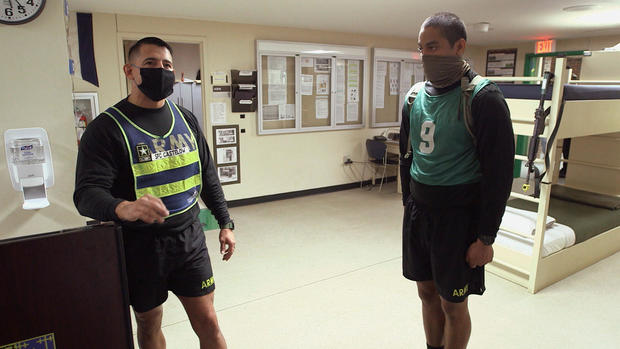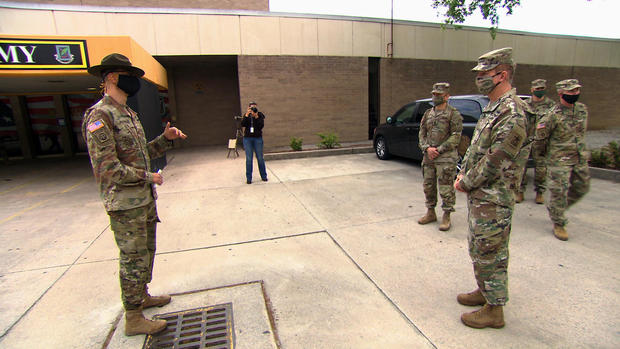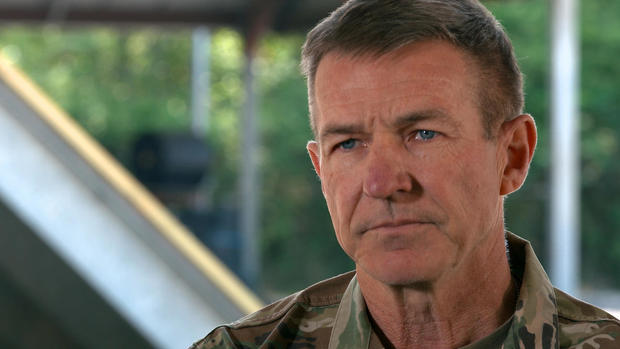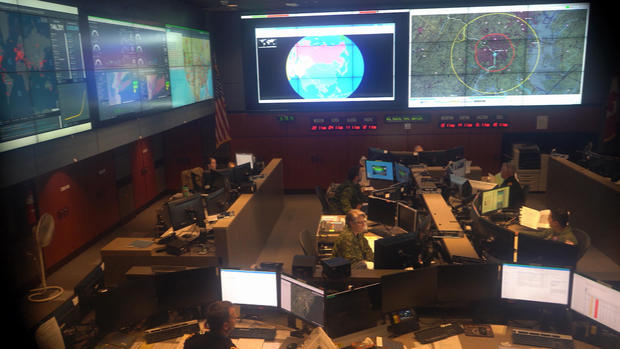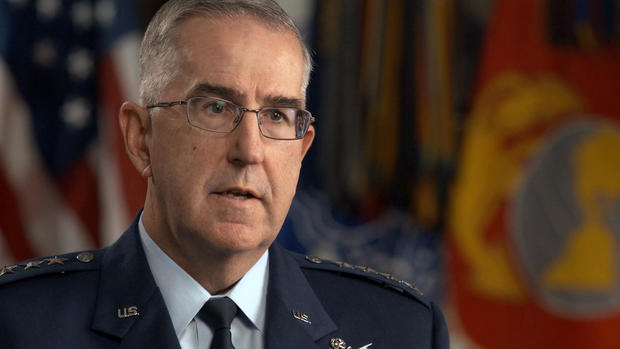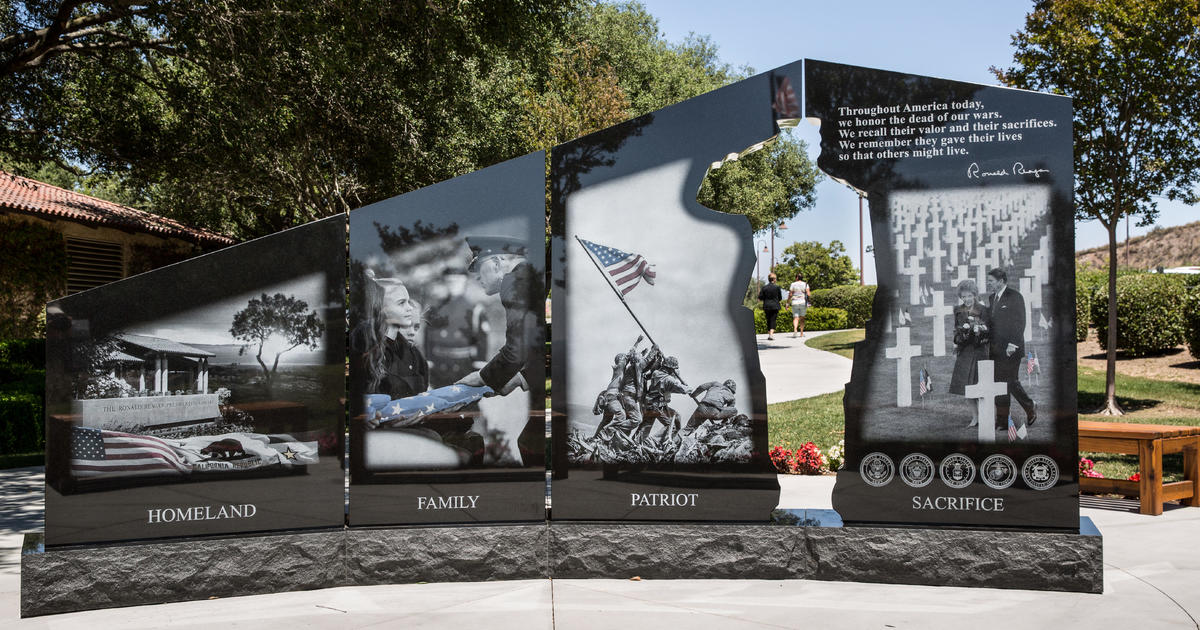Fighting an unseen enemy: How the military is protecting itself from the coronavirus pandemic
Anyone joining the United States military takes an oath to defend the country against all enemies foreign and domestic. Safe to say very few of them had coronavirus in mind when they raised their right hand. By latest count, some 60,000 servicemen and women have been sent into action against this new enemy. But the military's number one mission has been to defend its own ranks against infection. It can't protect the nation if it can't defend itself. The aircraft carrier Roosevelt made headlines when the coronavirus ran roughshod through its crew. And there have been other outbreaks that required drastic measures to contain. The U.S. military was up against an enemy it could not see and did not understand.
Everything in the Army starts with basic training. And every day starts before dawn. But it never looked or sounded like this before.
Drill Sergeant David Castelow: Hard surfaces. Everything that your little hands touch. Everything! It's gotta get wiped down. Your beds – everything! If it's a hard surface it collects dust. You're gonna wipe it down. Do you understand?
RECRUITS: Yes, Drill Sergent!
It's not dust Drill Sergeant David Castelow is worried about. It's coronavirus. And that's why he takes every recruit's temperature first thing.
Drill Sergeant David Castelow: If your organization is infected by something like this, you know, these people, these initial entry trainees, are our combat power. So if they go down, or and if we can't do it safely, then we are rendering ourselves obsolete.
Last month, 63 recruits in a class of 940 here at Fort Jackson, South Carolina, tested positive for the virus and upended basic training.
Drill Sergeant Porter: You're going to do everything that I tell you. You do not move unless I tell you to.
That's not a recruit he's barking at. It's a four-star general, Army Chief of Staff James McConville.
McConville took on the role of a recruit to witness the revamped training first hand after the coronavirus had forced the Army to stop taking in new soldiers.
Gen. James McConville: We took a two week pause.
David Martin: So for two weeks, you're not taking in any recruits?
Gen. James McConville: That's correct.
David Martin: Has that ever happened before?
Gen. James McConville: I'm not aware of any time – at least, in my 39 years where we stopped taking recruits in. But these are different times.
Training is still going on at Fort Jackson for recruits who arrived before the two-week pause. But now every soldier is wearing a face mask, loading up on hand sanitizer before moving into firing position and trying to stay six feet apart.
We call it "social distancing." The Army calls it "tacticial dispersion."
Lt. Col. Patrick Collins: We have been executing socially distanced enabled training since week 2.
Either way, Lt. Col. Patrick Collins tells Gen. McConville it's a problem.
Lt. Col. Patrick Collins: Day to day our biggest problem is keeping them in that six feet. Because, you tend to tell them, "O.K. separate. Get your six feet." You know, a couple minutes later, you know, just kind of natural human behavior. They start clustering again and you, and you, you've gotta tell them again.
Nothing at Fort Jackson is natural anymore. The Army likes to say it has the best dressed soldiers in the world, but tailors who usually alter uniforms for a better fit are now turning out face masks.
Gen. James McConville: These just got here. These are brand new.
David Martin: Brand new?
And the single most important equipment McConville saw on his tour was a pair of high-speed COVID-19 test machines.
Col. Koenig: That'd give us the ability to test 750-plus in one day with a one-day turnaround. And then they go and we can then test that bubble also. We can continue to expand the bubbles of testing so that we can make sure we can cut it off right at the source, rather than watch it spread through a unit.
The chief of staff's job is to get the Army ready to fight. But these days, Gen. McConville told us he spends three quarters of his time trying to fight coronavirus to keep his soldiers healthy. Just six weeks ago he was sending heavy armor to Europe for one of the largest exercises since the Cold War.
Gen. James McConville: The toughest decision that-- that we had to make was to cancel Defender 20.
Defender 20 meant sending an entire division-sized force and its equipment to Europe, just as the virus was assaulting the continent.
Gen. James McConville: We just started war-gaming what would happen if we had 15,000 or 20,000 soldiers in a very close environment and, you know, and the virus broke out? How would we take care of them? And did we want to put our soldiers at that much risk for a training exercise? And we chose not to.
David Martin: You have to curtail training. You have to postpone major exercises. That's got to take a toll on the readiness of the Army.
Gen. James McConville: From where I sit, I'm looking at the long game, and the long game is that we have to protect the force to protect the nation.
David Martin: How big a price have you paid so far?
Gen. James McConville: I don't think we've paid a huge price yet. Am I concerned long term? Absolutely.
Brig. Gen. Pete Fesler: I'll be honest. It's been a little bit intimidating thinking about it. You train in your career to fight an enemy that you can see. This is one that you can't.
Air Force Brig. Gen. Pete Fesler, a fighter pilot, is about as far removed from basic training as it gets, underneath 1,500 feet of granite at this command post inside Cheyenne Mountain, Colorado.
Brig. Gen. Pete Fesler: It is a secure location that we intend to operate out of in wartime.
David Martin: Well, this is wartime, isn't it?
Brig. Gen. Pete Fesler: It is, but it's really a different kind of war.
Cheyenne Mountain was built to withstand a nuclear blast but every time a watch team makes this half-mile walk into the mountain, they risk bringing the virus with them. Which is why each team spends 14 days in quarantine before going on duty. When their watch starts.
Brig. Gen. Pete Fesler: The first step you do is you start wiping down every surface, your computers, your telephones, your desk surfaces, door handles, etc. to make sure that all those are clean as well. It's a bit like an obsessive compulsive disorder (laugh). But we have to be able to make sure that there's no exposure to that virus.
Because our 60 Minutes team had not been quarantined, our cameras were not allowed inside the mountain. This footage was shot by the military. The interview was conducted from the Pentagon.
Brig. Gen. Pete Fesler: When occasionally we have to bring somebody from outside into our bubble for work on an IT system, for example, we scatter like cockroaches. It's as if this is the most dangerous thing we've ever done in our careers. It's not being shot at. It's not flying combat. It's actually having somebody from outside the bubble arrive inside of here.
This command center performs what Fesler calls a zero-fail mission: a 24/7 watch against a missile or bomber attack on the United States. Since the pandemic began, Cheyenne Mountain has scrambled jets to intercept Russian aircraft off the coast of Alaska three times.
David Martin: You think they were testing you at all to see if anybody was home at Cheyenne Mountain.
Brig. Gen. Pete Fesler: I suspect that the way that they look at those sorties probably is related to understanding our ability to operate in a COVID environment.
Cheyenne Mountain was ready for the Russians but not for the coronavirus.
Brig. Gen. Pete Fesler: This is something new. This is something that we had to invent on the fly as our adversary was not exactly like the one we had planned to fight.
Gen. Terrence O'Shaughnessy: There are so many aspects of what's going on now that are not things that we expected that we would be doing.
Gen. Terrence O'Shaughnessy, head of the U.S. Northern Command, is the man in charge of defending the homeland. He had plans for dealing with all kinds of disasters, including a pandemic, but nothing on this scale.
Gen. Terrence O'Shaughnessy: Often we practice what we call the complex disasters, where we might have an earthquake, maybe, that hit multiple states and we consider those to be complex. And to have a national-- actual disasters declared in the 50 states and the responses happening with them, that is unprecedented.
David Martin: So, you know the old saying about plans, no plan ever survives first contact with the enemy.
Gen. Terrence O'Shaughnessy: This plan did not survive contact with the enemy.
Despite all the top secret intelligence he sees, O'Shaughnessy did not have a good understanding of the virus.
Gen. Terrence O'Shaughnessy: Having an enemy that you don't fully understand is always a little bit frustrating.
Gen. John Hyten: We still don't fully understand the virus.
Gen. John Hyten is the vice chairman of the Joint Chiefs, the number two man in the military. Twice each day he holds a video conference with the pentagon's crisis management team located two floors below in the national military command center.
Gen. John Hyten: We had so many assumptions of what a virus would do, what a pandemic flu would do. And then when you actually see what coronavirus does, what COVID-19 does, it's completely different.
The nastiest surprise was the aircraft carrier Roosevelt. Not only did the virus sideline one of the most important ships in the Navy but the majority of the more than 800 crew members who tested positive had no symptoms.
Gen. John Hyten: You think you finally start to understand it, and then you get data off the Theodore Roosevelt, of the very large number of asymptomatic cases. And then you try to understand whether the asymptomatic cases are contagious. How contagious are they? That's medical questions that we still don't fully understand the answers to.
Many of the answers depended on testing and the Pentagon had to use its transport planes to airlift millions of test swabs into the United States from Europe.
David Martin: From the outside looking in, it seemed like it was one emergency stopgap shipment of medical supplies after another. Was that what it was like on the inside looking out?
Gen. John Hyten: On the inside looking out I'll say it didn't look like an emergency but it was difficult. It was difficult to figure out exactly where to go. And then when we decided to move-- we had to move quickly to get it in the right place. But the one thing that we do really well is we move stuff.
The Army Corps of Engineers set up hospitals like this one at Chicago's McCormick Place Convention Center all across the country, creating by last count about 15,000 beds in case local hospitals were overwhelmed.
David Martin: Were those hospitals the last line of defense?
Gen. John Hyten: We looked at it as the last line of defense.
David Martin: Where would the medical personnel to staff all those beds come from?
Gen. John Hyten: I have to be honest, we were worried about whether we'd run outta capacity early on when we were lookin' at those big numbers. It was not just space but, we were worried about doctors, nurses, corpsmen, respiratory therapists. We were worried about all those things.
David Martin: If this virus had not been slowed by social distancing, would the U.S. military have had the capability and capacity to defeat that virus?
Gen. John Hyten: That's what we were worried about. A situation where we woulda been basically mobilizing everything we had. It would been a different world. And I can't tell you right now how we woulda closed that.
It's a question the American military rarely has to ask itself, but the definition of what it takes to be a superpower has changed forever.
David Martin: So what will it take to get the military back to normal?
Gen. John Hyten: 2019 normal will never exist again. We have to figure out how to operate and fight through a world where coronavirus exists. If we just wait for what, you know, everybody hopes is gonna happen, which is the disease goes away, and it doesn't, and we haven't planned for the-- for the other case, we're in a bad situation.
Produced by Mary Walsh. Associate producer, Tadd J. Lascari. Edited by Patrick Lee.
